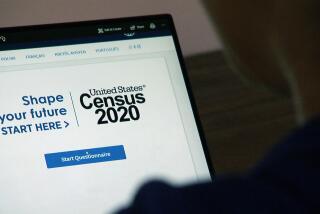Little Effect Seen by Adding Multiracial Listing to Census
- Share via
WASHINGTON — Adding a multiracial category to the 2000 census is unlikely to affect the way most black or white Americans identify themselves, but it could reduce the number of respondents who choose other racial categories, the Census Bureau reported Thursday.
The creation of a mixed-race category has been proposed by multiracial advocacy groups who contend that existing classifications force them to make a choice between the racial identities of their parents. Critics, however, argue that a mixed-race category could reduce minority head counts and weaken enforcement of civil rights laws.
The Census Bureau study suggests that the effect of a mixed-race category on the overall black-white population balance would be negligible.
“While everybody in this country tends to think of the multiracial category as black and white, the study suggests that it would have no effect on the overall percentages in the way black and whites report themselves to the bureau,” said Roderick Harrison, a Census Bureau demographer who conducted the study. “Not enough blacks or whites chose the category to vary their counts.”
The study was prepared for the White House Office of Management and Budget, which will decide later this year whether to add a mixed-race classification to the next census questionnaire. Existing racial categories include black, white, American Indian/Alaskan Native and Asian/Pacific Islander. (Census officials regard Hispanic as an ethnic classification, but not a separate racial group.)
The study is the third in a series of surveys designed to assist OMB officials in deciding on possible questions for the 2000 census. Conclusions were based on responses to sets of eight survey questionnaires sent to 112,100 households in geographic areas with high percentages of racial and ethnic groups.
Rather than seeking a raw count of racial groups, the study sought to analyze alternative methods of asking racial questions. Researchers wanted to find out, for example, how to increase Hispanic response rates, and whether the order in which ethnicity or racial questions are asked makes a difference in the responses.
The most practical finding was a slight decline among the targeted Asian/Pacific Islanders and American Indian/Alaskan Native groups when respondents were given the option of choosing a multiracial category. This tendency also was found in previous national surveys.
Harrison said it is “understandable” and “predictable” that Asians and Native Americans would be more willing to embrace the multiracial category than black and white Americans. He said that interracial unions have been more prevalent among Asians and Native Americans. As a result, their children are more likely to choose a multiracial category.
Data taken from the 1990 census show about 1.5 million interracial couples in America, with 92% of those couples including one white partner. Asian and Pacific Islanders accounted for 31% of those who had married whites; American Indian and Alaska Native accounted for 22% of those married to whites. Blacks accounted for 14% of those married to whites.
At a news conference earlier this week, before the study was released, Rep. Xavier Becerra (D-Los Angeles), chairman of the Congressional Hispanic Caucus, expressed concern that changes in the wording of the census form could hurt some minority groups. If the responses to new questions “dilute” how the government identifies ethnicity and race, government programs directed at minorities could be undermined, he said.
Rep. Danny K. Davis (D-Ill.), for one, said that he is strongly opposed to adding a multiracial category. That option “has the possibility of diluting the numbers of large minority groups . . . and taking away their opportunities for entitlement,” Davis said.
Census data on racial groups have been used for two decades to meet federal statutory requirements in monitoring and enforcing civil rights in such areas as housing, mortgage lending, educational opportunities, federal employment and voting rights.


